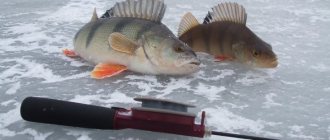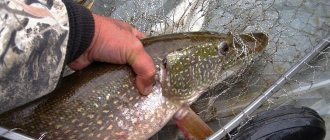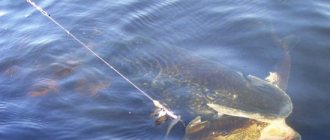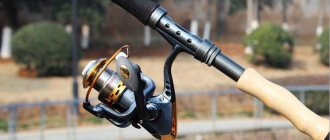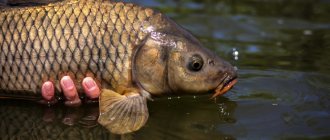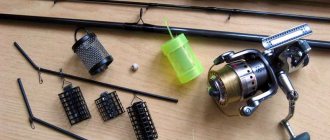What kind of bait is this?
A streamer is a bait that masterfully imitates fry, mice, tadpoles and frogs. It is most often made from synthetic materials, goose or chicken feathers, and rabbit fur. The choice of components is not accidental. They are the ones who are able to maintain the required volume in the water and guarantee the most natural game possible, lulling the vigilance of the fish.
The choice of material for streamers depends on what goals you are pursuing.
- synthetic ones have shown the greatest effectiveness when catching pike perch and pike perch. They perfectly retain their original shape and dry quickly, but do not “work” well in conditions of strong current;
- feathers are especially attractive to asps. They are distinguished by smooth, uniform movement. If you supplement them with a head made of deer fur, then such a bait will become the best in intense currents;
- fur . Ideal for both standing water and strong currents. Characterized by natural behavior. This bait is good for catching pike.
Regardless of the material of the streamer, your artificial bait will strikingly resemble live bait, which means that the likelihood of catching a trophy fish increases significantly.

Pike caught on a streamer
Design and advantages of the bait
A fishing streamer is a unique bait that is used when fly fishing. Externally, it looks like a hook with a long shank, to which a variety of materials are tied, both artificial and natural, made from feathers, hairs or fur. After immersing such an invention in the water column, the fish gets the impression that it sees a fry.
Due to its unique design and shape, the streamer performs a high-quality imitation of small creatures that are part of the diet of aquatic inhabitants.
And although you can find a wide variety of such baits on sale, the classic option is the one equipped with wing-shaped parts longer than the hook.
The history of the appearance of the streamer goes back to the distant past. It is known that the product was popular in the northern regions where salmon can be caught. At the same time, Volga fishermen successfully used it to catch chub and asp. To do this, they installed a sharp hook equipped with small feather feathers on the fishing rod.
In most cases, the streamer is used for fly fishing, although today it is also used in spinning fishing. As experienced spinning fishers say, this unique bait works no worse than silicone or foam fish. You can use any drop sinker as a load, or use the connection method through. Installation of a “diverter leash” is also effective.
Advantages of the device
This amazing fishing bait is extremely popular for simple reasons:
- It is easy to make it with your own hands, giving it individuality, suitable sizes and colors.
- Any materials are used for production.
- The casting range remains maximum, and the aerodynamic properties remain at a high level. The bait does not go into a “corkscrew” and does not have windage.
It is no secret that many modern baits are made like fry, but they do not always arouse the fish’s interest, because they are not able to imitate the natural movements and behavior of small prey. Only by adjusting the game and using a few tricks will the situation improve and the chances of a good bite increase.
In the case of streamers, everything is completely different . There is no need for manual adjustment, because the bait behaves excellently in any conditions, creating a high-quality imitation of fry. This is ensured by the presence of fur and feathers, which have a certain flexibility and naturalness.
Many fishermen have a lot of doubts when purchasing such an invention, because there is an opinion that the small size of the streamer (up to 5 centimeters) makes it unattractive prey for large fish. But this is a misconception, because sometimes real trophies come across it.
Among the significant advantages of the bait is the ease of making it yourself using improvised materials. Moreover, this does not require spending a lot of effort and time.
Pros and cons of streamers
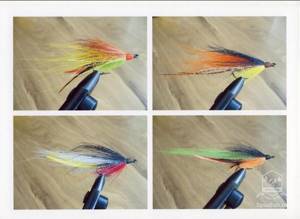
If we talk about the advantages, then it is worth noting, first of all, the high naturalness when guiding in shallow water, ease of mating and low weight. In addition, predators peck at streamers during periods of low activity.
It has been repeatedly proven that such bait awakens hunting instincts even when the “owner of the waters” is not hungry and chasing food is not part of his plans. And if you are lucky and you successfully throw the tackle into a school of fish, you can easily catch several individuals at a time.
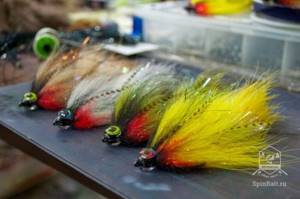
It is impossible not to note the good passability of the bait in the grass and snags. It is equally effective at different depths. The compact size allows you to cast over long distances. At the same time, the streamer does not sail or spin. What makes the bait popular is its versatility and out-of-season nature. You can catch any fish with it at any time of the year.
But what about the cons? Do streamers have any disadvantages? Of course, it couldn’t have happened without them. The main disadvantage of this type of bait is the need for empty casting. Fur “fry” quickly absorb water, after which they are no longer so easy to cast. By the way, synthetic streamers do not have this drawback.
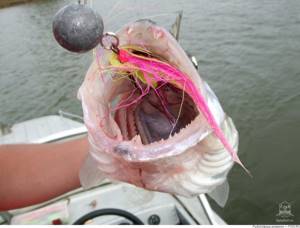
Equipping the jig head with a streamer. Pike perch did not remain indifferent!
Subtleties of pike fishing
Success in streamer fishing depends on several factors. Firstly, the fisherman needs to correctly determine the fishing location, since different parts of the reservoirs will be effective in different seasons. In summer, a large number of bites are expected near aquatic vegetation. These can be islands of egg capsules and pondweed, or a coastal strip of reeds and reeds. In winter, early spring and autumn, this bait is best used near grooves, edges, on riffles, and near various shelters near the shore.
Secondly, it is important to choose the most suitable streamer wiring. The more experienced the fisherman, the more animation techniques he knows. The variability of fishing techniques allows you to catch pike under any conditions. This skill is especially reflected when fishing a passive toothy beast standing motionless in a shelter.
You can fish with these baits in various bodies of water, but the most interesting and exciting is fly fishing for pike on small rivers. Here, almost all of the predator’s exits and subsequent bites are visible to the fisherman, which brings a lot of emotions. Often the fish attacks the streamer right under your feet, making a powerful and sharp jerk. Such incidents are remembered for a long time and are pleasant to remember on boring evenings during the off-season.
Nuances of fishing
You can fish with streamers using a fly rod and spinning rod. When fly fishing, you should be especially careful when choosing a fishing rod. The optimal length is 2.4 m. It is also important to choose the right location. In autumn and winter, luck lies in wait in narrow canals, small lakes and ditches, near banks densely covered with vegetation. In summer it is better to fish near reed thickets, near large stones, and on rifts.
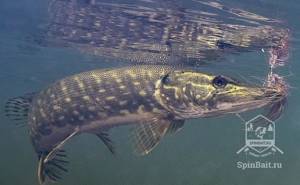
The ability to “read” water comes with experience. But most often, river bends, shallows and sharp changes in depth, and places overgrown with algae turn out to be promising. You should also take into account what the fish are currently feeding on and choose the most suitable one from the available streamers.
And also, in the warm season, give preference to dark streamers - black, burgundy, dark green. On cool days, predators prefer bright baits - light green, orange, golden.
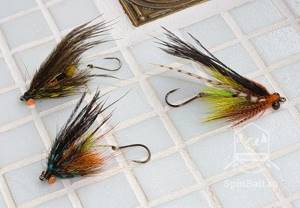
For pike you need large streamers, for perch - smaller ones. Although there are exceptions. Sometimes the pike is caught on small things, and the miniature crucian carp tries to attack the large bait. The predator reacts to the bait during the movement phase. For this reason, it is necessary to keep it taut with a cord. Sharp tugs on the tackle, and the resulting active jerks, force the fish to attack. Throw streamers upstream 1-2 meters above the selected point. After casting, remember to constantly monitor.
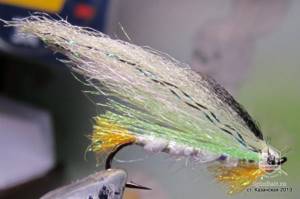
When fly fishing, the fish are spotted by themselves. When this happens, pinch the line, which should be taut, and lift the rod up. Don't relax - the slightest mistake and the predator will get off the hook.
Often, streamers act as an auxiliary means to whet the predator’s interest in the main bait. That is why a “train” is attached to the fishing line - several flies at short intervals.
Fly fishing
If we talk about fly fishing, then it is important to choose the right gear, taking into account its strength and reliability. The optimal length of the form is at least 3 meters, and it must correspond to class 7/8. Beginners who have never fly-fished before and are just trying to figure out the basic operating aspects can use lighter flies.
Braided cord is selected taking into account the class of the fishing rod . Both sinking and floating models are used, and each variety is suitable for specific fishing conditions. For example, if fishing is carried out on a lake, then it is advisable to use a sinking variety.
The size of the undergrowth reaches 1 meter. This element is considered indispensable, because it allows you to conveniently cast and control the fly. After casting, you need to allow the bait to sink to the appropriate depth, and then begin to make periodic pull-ups so that it begins to play in the water column. It is not necessary to constantly monitor the bite, because if you are going to catch trout, the blow will be so powerful that the fish will detect itself.
If we are talking about catching perch , then you need to have time to hook at the right moment. In this case, you need to be careful, because any harsh movements can damage the weak and sensitive lips of the striped predator. When choosing hooks, use fairly sharp models, especially if fishing is carried out in an open, spacious body of water with standing water. Running the streamer in an area where there is no current can cause you to lose control of the fly.
A lot depends on the angler’s readiness to hook the prey in time. At the same time, the sharpness and reliability of the hook allows you to successfully preserve the fish until you feel the jerks. When fishing on fast-flowing rivers, the requirements for the selected gear are significantly reduced. Instead of a sinking cord, floating models are used, as well as standard undergrowth.
Retrieving is done by moving against the current, throwing the gear in front of you and then moving the streamer down by pulling the cord.
How to make a streamer with your own hands
As already mentioned, streamers can be made independently. There are no particular difficulties in this. You will need bird feathers (pigeons, ducks or chickens), animal wool (goats or sheep), fur (rabbit or squirrel), Lurex, woolen threads, foam rubber or New Year's "rain".
- take a scrap of wool, a bunch of feathers or a piece of fur and attach it to the hook so that the middle falls on the eye;
- fix the future bait with a nylon thread, wrap the free part of the feathers or wool towards the forearm;
- tie a double-folded base of a piece of fur or a bunch of feathers, forming a small thickening - the “head” of the fry;
- tie the thread in a knot, cut off the ends, comb the bait and apply waterproof glue to the thickening and knot;
- color the bait red, yellow or green.
But for the streamer to be truly useful, when making it, you should take into account the type of fish you are going to catch and wisely choose the hooks and color of the future bait.
- asp . To catch asp, streamers tied on hooks No. 6-10 are used. It’s good if the bait is painted white or red;
- perch _ In this case, you should take hooks No. 6-12. Recommended shades: light green, black, red, orange. The body of the fry can be made from marabou feathers, the head from a red bead, the tail from red rooster feathers;
- zander _ Streamers tied on hooks No. 4-10 made of artificial golden threads have the greatest catchability;
- trout . Hook numbers are 10-12. Favorite colors of trout are orange, light green, black. A streamer can be made from a simple synthetic dust brush or from thin satin ribbons;
- saberfish _ It is better to take hooks No. 6-10. Streamer color is shiny gray or white;
- pike . Experienced fishermen believe that catching pike with a streamer is a random occurrence. Whether you agree with this or not is up to you. One way or another, this cautious predator most often falls for perch flies.
As you can see, making a bait with your own hands is not difficult. Master the technique of fishing with a streamer if you have the desire - too. Apply the theoretical knowledge gained from this article in practice, and may luck accompany you always when you pick up a fishing rod!
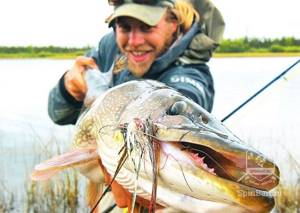
Options for mounting equipment and fishing techniques
There are three options for using wabiks when fishing for pike.
Fly fishing
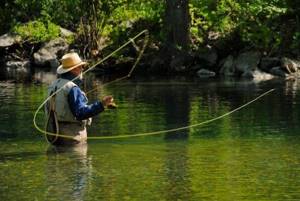
During pauses, wiggle the rod to make the streamer attractive to the fish.
The same technique is used when fishing with spinning rods . For this purpose, streamers with metal heads , which are much easier to cast and navigate in the lower layers of water .
During retrieving, you can either perform jerks with the rod, picking up the slack in the line after each of them, or use reel-in with pauses.
Using wobbles with spinners and wobblers
Another option for using spinning tackle is to tie several reels on separate leashes in front of a spoon or wobbler. In this case, the pike will attack both the main bait and the wabiki .
It is generally accepted that in the first case, the predator perceives the spinner or wobbler as a competitor that hunts in its territory. If a fish grabs a streamer, this may be a consequence of the awakening of the hunting instinct - the pike perceives the bait as potential prey that could go to another predator. It is represented by a spinner or wobbler .
It is difficult to say what actually motivates the fish at the moment of attack , but it is certain that using wabiks as an addition to the main bait significantly increases the number of bites .
Jig fishing with streamers
Another option is to use a streamer as a jig bait . Usually equipment for bottom fishing with a Cheburashka sinker . Classic wiring with a bottom step is performed. This method is suitable for catching pike at depth , when it hunts in the lower layers of water and reacts to jigs. Silicone baits are used much more often in such fishing , but foam rubber and streamers will be an excellent addition to the spinning arsenal.
Thus, a streamer is a universal bait with which you can catch pike in various conditions . It is not difficult to make it yourself; in this case, using wabs allows you to save . Knitting streamers with your own hands is an interesting and exciting process , which provides scope for creativity and is of interest to many fishermen. You should definitely pay attention to this bait if you haven’t tried it yet - with the right approach to the matter, the results will certainly please you .
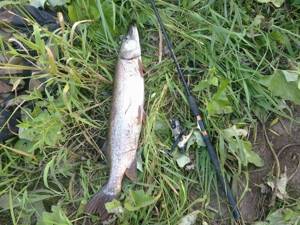
What it is?
A streamer is a fly fishing bait that, with its appearance and behavior when retrieving, imitates a small fish, insect, tadpole, frog and other object attractive to a predator. Essentially, this is a large fly designed for large prey. That is why it is so effective when fishing for pike and is popular for a reason.
Pike streamers can come in a wide variety of shapes and be made from different materials. Most often these baits are made from:
- animal furs;
- bird feathers;
- synthetic fibers.
Photo 1. Material for streamers.
Experienced fishermen use various combinations of these materials, creating real masterpieces that turn out to be very impressive, realistic and, of course, effective.
Each material for a pike streamer has its own characteristics, which must be taken into account when choosing a specific bait model. Synthetic materials dry quickly and can retain their original appearance for a long time. However, they do not behave well in strong currents.
Advantages of bait
Catching pike with streamers can be successful at any time of the year. Regardless of the fishing season, the toothy beast readily responds to a passing object, which has realistic shapes and imitates real prey with its movements.
Pike streamers are a phenomenal bait that has a number of advantages:
- Although it is intended for fly fishing, it can also be successfully used in spinning. It can be cast using lightweight ultralight rods and thin lines. This bait is suitable for different types of fishing.
- Streamer is a unique bait that allows for the most diverse animation techniques. It works great with a uniform feed and responds to any jerks and pulls.
- The bait is suitable for fishing in shallow water. Thanks to its light weight and windage, the streamer can be carried at a slow speed along overgrown shallows and spits.
- The streamer is used both on active toothy predators and on sluggish passive pike. It is good at seducing apathetic fish that refuse to take other baits.
- The bait has good permeability, so it can be used among algae and snags.
Tying a simple but working streamer for pike is quite simple. Therefore, any angler should not ignore this simple, but very effective bait. It must be in the arsenal of any fly fisherman or spinning angler involved in ultralight fishing.
Photo 3. Fantasy streamer.
No matter how much they praise the streamer for catching toothy pike, any, even the most versatile and productive bait, has its drawbacks:
- Many streamers are not able to withstand the greedy bites of a predator for long, so the baits cannot be called durable.
- Streamers made of fur or feathers quickly become wet and may lose some of their positive properties. This often affects the range of baits.
- Properly selected and sensitive gear is required to guide streamers. With an unbalanced set, you shouldn’t count on stable catches.
In general, a streamer for pike is more of a positive and simple bait that any hunter of a toothy beast needs to have in his box. You should definitely try fishing for it. Perhaps she will become “number one” for many years.
Streamers
Streamers in fly fishing imitate not insects, but fry of fish, frogs and even mice, although they are not their exact copy. Fly fishing uses these baits to catch mainly predators. Classic streamers are made from the feathers of the marabou bird, a type of stork, or from rabbit fur. These materials provide a unique play of the streamer and keep the volume in the water. Chicken feathers are added to increase mobility. Actually, they make synthetic streamers and use other feathers. Synthetic streamers are suitable for fly fishing for perch and pike perch.
You can watch the knitting of the streamer in the video:
The best flies
Due to the ease of tying and the availability of materials, Woolly Bugger flies are often the first streamers that a beginning knitter uses. This is a streamer, the bushy tail of which is made of marabou feather, the body is made of chenille, and a rooster feather is wound on top of it in a spiral. But the main thing about the streamer is the marabou tail. There are many options for making the body: from wrapping the same marabou feather around the forend that the tail is made from, to making fancy dubbing loops filled with fur or synthetic fibers like 4Trouts Foxy Silk. The use of such a thread is complemented by a simultaneous imitation of feather and chenille, called “brush” by fly fishers. By attaching a lush marabou feather wing to the head of the Woolly Bugger, we get the best fly for trout fishing in ponds shown in the photo.
The name of this very catchy fly is Cat Whisker. You can experiment with colors, materials and knitting techniques. The main thing is that you and the fish like the streamer, then the pleasure of fishing will more than compensate for the time spent at the machine.
The Woolly Bugger imitates a variety of freshwater and saltwater fish food items. Leeches, crustaceans, shrimp, fry, tadpoles and lamprey larvae are the list of imitations of this streamer, which is considered the most versatile. fish with it everywhere. It is important to choose the right wiring, speed, length of pull, and the duration of the pause between them. It is desirable that the streamer's wiring correspond to the movements of the object it imitates. Remember that for each fish and for any fishing you should select your own bait color and wiring, so you need to tie and have flies of different sizes and colors in your arsenal. Next, start experimenting on a pond. Success will come quickly, and with it it will become clear what colors and sizes the fish prefers.
The presence of flies of different colors and sizes will allow you to catch all kinds of fish. I used the Woolly Bugger to catch rainbow trout on the mountain river Lyutyanka, lake trout on northern rivers and lakes, and pike in floodplains and estuaries. It is very effective in catching perch, which is extremely partial to the play of the marabou feather tail. In the fall, on the rivers, I successfully catch chub under the bushes, and in the summer, saberfish in the “returns” and asp in the seething stream below the dams. Great success has been achieved by spinning knitters who knit these streamers on the hooks of turntables. Spinning flies are a new and interesting trend that has now captured many minds. I repeat once again that the main components of success are the assortment of flies in the flybox and continuous experiments with wiring.
Among the color preferences, the following should be highlighted: chub prefer black and orange compositions, pike and pike perch prefer yellow, red, white and black. Crucian carp responds well to slow pulls of a brown and red streamer tied on a hook No. 12-14. And a completely white fly with silver or blue sparkles is a real asp delicacy. A red feather collar would be a good idea. At the same time, remember that spring asp flies should be smaller in size (hook No. 6-8), and autumn flies should be larger, tied on hooks No. 1-4. This is explained by the fact that the asp’s food items are growing.
Catchy streamers are zonkers
These beautiful and very catchy flies are also combined into one group based on the material of the tail. A zonker is a streamer with a strip of fur in the tail of the fly. Knitters also call narrow strips of skin with fur a zonker. The body of a zonker fly can be knitted from a variety of materials: chenille or shiny poly chenille, fluffy dubbing thread brushes or braided body tubes. You can simply wind flat lurex over the fore-end and secure it with wire, which will simultaneously attach a strip of fur to the fore-end. The head of this streamer can be beautifully made by winding from strips of fur cut across, and the collar can be made from three to five turns of a bright rooster feather. It all depends on your imagination and the object of imitation. An imitation leech or tadpole can be knitted from a single strip without forming a thickened body, and when imitating a fry, it is better to make the body shiny and thick, reminiscent of fish scales. When you finish knitting the streamer, turn it upside down and apply a drop of waterproof glue or mounting varnish at the point where the skin comes out of the hook, as shown in the photo on the left. Smear it a little 3-5 mm over the skin. Without bending the strip of fur, let the glue dry. This will allow the zonker's tail to avoid getting caught on the hook.
As for the choice of color, white and gray are more suitable for imitating fry; dark brown color is used for making benthic imitations of loaches and sculpin gobies. Black and olive tones are needed to imitate leeches, while red, burgundy and purple colors are excellent for imitating crawlers and earthworms. To make modern zonkers, a variety of materials are used: rabbit, mink, fox, nutria, and squirrel fur. Each fur has a unique game - the rabbit is soft and very active, the squirrel is more slender. Look at the striped zonker playing in the water, where the fur has sparse dark or bright transverse stripes.
A fly fisherman who sees a streamer with a striped bunny tail play immediately becomes a fan. You can draw such stripes on the fur yourself using a waterproof marker. The issue of the size of the streamer is also important. To catch pike, it must be larger and more voluminous; for pike perch - heavily loaded, low-profile and propulsive; for crucian carp or sabrefish – very small. To catch perch, and especially trout, the tails of the flies should not be made very long, as this results in a lot of idle bites, and the number of fish is depressing. When you fish on a fishing platform and take the fish home, use two hooks in the streamer. As an option, you can stitch the skin with a braided stitch, and tie a small hook with a short shank at the end.
All types of trout are excellently caught on the Zonker-Muddler streamer model, where the best color is a natural gray-brown. When going fishing for pond trout, it is advisable to knit zonkers in brighter and contrasting colors. For example, with a white or black head and an orange tail. Bright colors and fluorescent colors will not allow the pike to swim past. I recommend catching perch with dark olive, green and orange flies. Carp fish are partial to burgundy, black, dark green, dark brown small zonkers. Large autumn chub are excellently caught on black streamers with orange elements. Pike perch bites well on yellow baits, while asp traditionally prefers white ones.
The zonker can be fished with both fly fishing and spinning. The wiring must include pauses, sometimes very long ones. When fishing in “windows” among water lilies, the zonker sometimes finds itself out of competition. To quickly catch a predator lying in ambush among thickets of aquatic plants, use an unloaded version of the fly. Throw the bait exactly into the gap and let it sink freely and smoothly. You can shake the rod slightly or make subtle pulls with the cord. The zonker's rabbit tail plays with every hair; it is so lively and mobile that even a passive predator has a desire to grab the bait with its teeth.
This streamer has a small disadvantage: when wet, the fur and skin become very heavy, which negatively affects classic fly casting. But for spinners this is a plus. However, when casting with ultralight, you should take into account the increasing mass and perform it more smoothly. In spinning fishing, where self-tied lures are increasingly becoming fashionable, such streamers are used in spaced drop-shot rigs and in the popular American “Carolina” and “Texas” rigs. For fishing in snags, it is easy to tie a streamer with a bumper made of thick fishing line. This protection allows you to avoid offensive hooks.

Classic streamers with wing
This is the largest group of streamers; they are united by the fact that they have a top wing. Within this group, two main subgroups can be distinguished: feather streamers, where the wing is made of feather segments, and fur streamers, where animal fur or synthetic fibers are used as the wing. The most beautiful, expensive and difficult to manufacture are classic salmon streamers. They often contain feathers from exotic birds and the fur of strange animals.
Rough materials and meticulous workmanship greatly increase the cost of classic salmon flies, raising it to stratospheric heights. Therefore, classic streamers migrated from salmon rivers to lowland reservoirs; now they are made using simplified knitting techniques and cheap plumage, which has made it possible to use them en masse and everywhere.
For tying streamers, you can use hooks without a ring bent down, and hooks for salmon flies are traditionally produced with an eye bent up, allowing you to make certain types of knots. A streamer on a hook with a straight eye, all other things being equal, is more stable in the water than with one bent down. And in order to avoid scrolling along the axis or turning the streamer over with its wing down when wiring, you need to choose hooks from fairly thick wire, for example carp series. The bend of the hook with the sting in this case acts as a stabilizing keel and prevents the streamer from lying on its side or turning over. The cause of the streamer falling to one side may be an excessive amount of material placed in the wing. Use larger hooks and try to minimize the amount of material in the wing, then the streamer will be much more stable.
Salmon streamers are used on the corresponding rivers, most often performing a “acceleration” with the current, casting at an angle of 45° to the opposite bank and allowing the current to “inflate” the line, which drags the fly at a speed greater than the current. On lowland rivers, this type of wiring can also be used if there is an appropriate current. Streamers with a wing also perform well with active wiring with pulls, which are called “strips”. Perch and chub respond especially actively to strip fishing. The main thing is to choose the tempo and amplitude of pauses, which are different for each body of water.
In lowland reservoirs, the vast majority of winged streamers imitate fry, which predators feed on. When choosing a hook for tying a streamer, it is necessary to take into account the size and color of the food objects. For pike, try to use long, voluminous and bright materials and a large hook - No. 1/0-3/0 will be just right. Perches are famous for their gluttony and cannibalism, so you can knit a streamer in olive-orange tones with stripes drawn with a waterproof marker. The red and chartreuse color combination for bass is a great choice.
Salmon streamers most often imitate either a shrimp, which reminds the salmon of its marine food preferences, or an aggressive and bright fry that encroaches on the integrity of its nest. One should be very careful when talking about the color preferences of salmon streamers. This is an extremely delicate topic that requires a separate approach and a special description. If you are going salmon fishing, remember that the color of your favorite flies can vary depending on the level and color of the water, time of year and weather conditions. For reservoirs in the middle zone, everything is a little simpler.
Source: FishingLov.ru
Good tackle
My gear for catching pike with a streamer consists of a 2.70 m long fly rod of class 8 or 9, a strong fly reel with a backing of at least 50 m, and a floating fly line. The cord must be floating, since the ideal areas for fly fishing on the Vuppu and on the “track” are considered to be small bodies of water (lakes, ditches, rivers) up to 2 m deep. Only on a floating cord can you reel in a streamer without hooks, slowly, with small ten-centimeter jerkily. Pike love it!
Fishing on a “track” with a floating line is also much better. There are no snags even with the slowest wiring. In addition, thanks to such a cord, when fishing on the “track”, you can change the direction of movement of the bait by forming a “sail” - an arc from the cord.
A two-meter piece of fishing line with a diameter of 0.40 mm is tied to the fly fishing line, then a mini-swivel with a piece of steel leash is placed.
